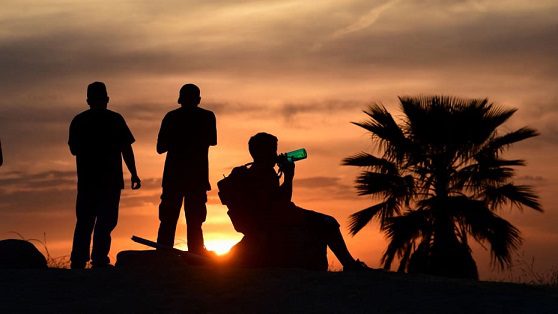American Heatwave Crises: No industry or business is immune to the US heatwaves Hot weather is hurting American businesses. Extreme heat is a growing concern for entrepreneurs and businesses, affecting worker productivity and operational costs.
Many regions are experiencing earlier, more intense, and longer summer desert heat. Phoenix, Arizona, residents and businesses have endured 23 days of 110-degree temperatures. Zydeco’s Louisiana Kitchen Food Truck owner Lyn Thomas knows the challenges entrepreneurs face in such conditions.
Heat is miserable. “It’s like breathing hot air,” Thomas said. “Even at night, it’s hot.”
Thomas, like others, had to adapt her business strategy to the extreme heat. She started a catering business instead of parking her food truck and waiting for customers in the heat. Businesses need this adaptability in a changing climate.
Extreme Heat and Economy,Recent studies show alarming economic impacts of extreme heatwaves. Extreme heat could cost the US $100 billion in productivity losses, according to Moody’s Analytics director of economic research Chris Lafakis. Calculating the economic impact of excessive heat is difficult due to its widespread effects.
Lafakis warned that extreme heat could drain one-sixth of global economic activity by 2100 if unchecked.
Outdoor workers in agriculture and construction suffer the most losses from heat. Workers work longer and produce less as temperatures rise. Supply chain effects affect consumer prices and economic growth.
“The way that heat hits us, our thinking gets slowed down, our concentration is really tough, our hand-eye coordination is off, we’re tired, we make mistakes,” said Atlantic Council’s Adrienne Arsht-Rockefeller Foundation Resilience Center director Kathy Baughman McLeod.
Outdoor businesses must protect workers from heat stress. Shade, water, and breaks improve worker safety and productivity.
Business AdaptationsBusinesses are implementing innovative heatwave strategies as the heatwave intensifies. In Holtville, California, the “carrot capital of the world,” farmer Jack Vessey has taken steps to protect his workers from extreme heat.
“Ice, water, shade,” Vessey said. He adjusts work hours to avoid peak heat.
The Texas roofing industry faces summertime challenges. New Braunfels-based Roofer Chicks takes longer to finish jobs on 100-degree days to allow for breaks and worker safety.
Roofer Chicks owner Zeyla Alcantara stresses heat-related risk education for workers. “Because it comes up fast, and you lose time with it if you don’t stay on top of it,” Alcantara said.


READ MORE: Economic consumer sentiment index: Resurgence Markets Soar as Optimism Reigns
The Broken Saddle Riding Company in New Mexico prioritizes animal protection in extreme heat. To protect the horses, the company rides during cooler hours and provides water, shade, and cooling.
Awareness and Government Action Employers and workers need heat awareness campaigns. The Arsht-Rockefeller Foundation Resilience Center is naming heatwaves and creating a health-based warning system to raise awareness of this “invisible, silent risk”.
No national heat-specific worker protection regulations exist, but California does. Businesses need government assistance to protect workers and adapt to extreme heat.
Heatwave Preparedness Businesses need long-term resilience strategies to deal with extreme heat. Businesses must adapt to climate change by using innovative cooling technologies and sustainable practices.
Extreme heat’s economic impact is complex and requires business, government, and individual collaboration. American businesses can survive the heat and secure a sustainable future by cooperating and prioritizing climate resilience.
Our Reader’s Queries
What was the worst heat wave in US history?
In July 1936, during the “Dust Bowl” era, the country experienced one of the hottest summers ever recorded. The intense heat was especially felt across the Plains, Upper Midwest, and Great Lakes regions. This scorching summer led to the tragic deaths of approximately 5,000 people nationwide.
Is 2024 going to be hotter than 2023?
According to climate scientist Andrew Dessler of Texas A&M University, 2024 is expected to be hotter than 2023, following the usual trend. However, Dessler notes that the “normal pattern” may no longer be applicable. Despite this uncertainty, 2024 is anticipated to be one of the hottest years on record.
What is causing the heatwave in the US?
Burning fossil fuels is driving climate change, which is set to make heat waves last longer, become even more intense, and occur more often.
Is 2023 the hottest year on record?
2023 smashed records as the hottest year ever, with every single day hitting temperatures at least 1°C higher than before the industrial age. It’s likely that the heat during 2023 surpassed anything we’ve experienced in the last 100,000 years, according to Burgess.

